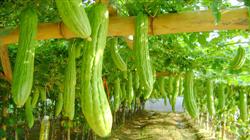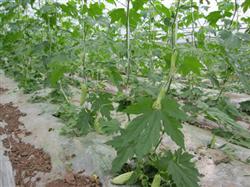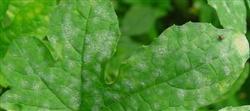How to plant pollution-free balsam pear?

How to plant pollution-free balsam pear? Please introduce planting methods for pollution-free balsam pear cultivation can refer to the following methods: variety selection should choose varieties with short vines, short internodes, small leaves, strong stress resistance, early maturity, high yield and storage tolerance, such as Huadu green balsam pear, which has strong plant growth. Strong disease resistance, from the third leaf to sit the first female flower, more fruit, flesh thick, tender, good quality. The cultivation season and stubble arrangement can be cultivated in early spring, late autumn, winter and spring in solar greenhouse and plastic greenhouse. The early spring stubble was sown from late December to late January and planted from mid-February to mid-March. In autumn, the seedlings were sown from late July to mid-August, and planted from early September to late October. Sowing and raising seedlings in winter and spring from early October to early November, and planting from mid-November to late December. The seedlings were raised in a nutrition bowl in the greenhouse. The seedling substrate was mixed with peat and vermiculite at a volume ratio of 2:1, and then 10 kg of dried chicken manure was mixed into 1 cubic meter of mixed medium. Put the nutrition bowl neatly into the seedling bed, water the substrate thoroughly, sow seeds after underwater infiltration, use 1 seed per bowl, dry seed direct seeding, and cover the seedling substrate 0.5 cm thick after sowing. The temperature is kept at 25-30 degrees Celsius before emergence, 20-25 degrees Celsius during the day and 10-15 at night after emergence. The nursery bed should be sprayed with a spray can for 1-2 times every morning or evening to prevent the matrix from hardening and drying. After the seedlings are unearthed, keep the soil dry and wet. If the seedling growth is weak, foliar fertilizer can be sprayed with aqueous potassium dihydrogen phosphate solution with a concentration of 0.2% Mel 0.3%. The seedlings were planted with 3 leaves and 1 heart, and the seedling age was 35-45 days. Before planting, the cultivation trough was dug in the north-south direction, with a width of 0.48 m, a depth of 0.15 m and a spacing of 0.8 m. The bottom of the trough was covered with a layer of plastic film to isolate the soil, and the substrate was filled with 2-3 cubic meters of substrate, and the ratio of cultivation substrate was straw carbon: slag 4:6. Before loading the trough, 5kg of dried chicken manure and 0.5kg of 15:15:15 nitrogen, phosphorus and potassium compound fertilizer should be mixed into each cubic meter of substrate. The cultivation substrate was turned and leveled, and watered once to make the substrate fully absorb water. After the water seeped, it was planted in the pit according to the specification of 1 row per trough, so that the substrate was slightly higher than the seedling snake, and the plant spacing was 0.4 meters, and water was poured after planting. Temperature management after planting: before flowering, the daytime temperature in the shed is maintained at 20-25 degrees Celsius and the night temperature is 13-15 degrees Celsius. After flowering, the daytime temperature in the shed is kept at 25-30 degrees Celsius and the night temperature is 12-15 degrees Celsius. In case of continuous overcast weather, heat preservation measures should be strengthened to make the day temperature not less than 18 degrees Celsius and not less than 8 degrees Celsius at night. Fertilizer and water management: control mainly before flowering, less watering and topdressing, and topdressing watering after flowering. Balsam pear root system like wet is not resistant to waterlogging, each time the amount of water should not be too large, should be watered frequently. It is usually watered once every 2-3 days. The fertilizer was applied with the water every two times, and the compound fertilizer of nitrogen, phosphorus and potassium at 15:15:15 was applied every 15 hectares. The natural pressure drip irrigation is used in the storage tank, and an independent storage tank is established in each shed. The pool is 4 meters long, 1.5 meters wide and 2 meters high, and the bottom of the pool should be 0.5 meters higher than the ground level. In order to prevent sunshade and occupy too much planting area, the pool should be built along the gables of the greenhouse or greenhouse. Plastic pipes can be used in the main pipe of the shed and the drip irrigation belt in the cultivation trough, with two droppers in each slot, and covered with a layer of narrow plastic film 0.1 mm thick to prevent drip irrigation water from spraying and evaporating. Plant adjustment: the use of shed support, 20-30 cm under the film to build 2 layers of scaffolding for melon vine climbing growth. After swinging the vine. Draw the vine onto the shelf with a rope. When the plant grows to the cage leaf, it hits the top, promotes the lateral branch to germinate, leaves 1-2 female flowers in the lateral vine, and leaves 2-3 leaves behind the second melon. Artificial pollination: after buckling the film, artificial pollination must be carried out in order to bear melon normally. Male flowers in full bloom were picked at 8-10:00 in the morning and pollinated by flowers. Fruit bagging: fruit bagging is carried out after flowering and fruit setting. The bag is 800mm long, 80mm wide and 0.08mm thick. It is a colorless and transparent polyethylene film bag. Put the film bag on the fruit, and then put the opening of the film bag together with string holes in the fruit stalk, but not too tight, so as to prevent the lateral growth of the fruit stalk from being affected, while maintaining a certain degree of ventilation. Fruit bagging can prevent pesticides from being sprayed directly on the fruit. Balsam pear has a strong ability to prevent and control diseases and insect pests, generally rarely occur serious diseases and insect pests, anthracnose and blight are easy to occur only in high humidity, and are vulnerable to aphids and whitefly when humidity is small. Anthrax can be controlled with 80% anthrax Fumei wettable powder 800 times, once every 5-7 days, even for 2-3 times. Aphids and whiteflies can be fumigated with 80% dichlorvos EC, or biological pesticides without pesticide residues can be selected for control. 12-15 days after flowering is the appropriate time for harvest. Harvest should not be too late, so as not to affect the quality of the goods. After bagging the fruit, when the listing standard is reached, the fruit will be listed together in the same bag. Click to get more balsam pear planting techniques click to get more vegetable planting techniques
- Prev

What should we pay attention to when planting balsam pear in June?
What should we pay attention to when planting balsam pear in June? Balsam pear branching is very strong, almost every leaf can.
- Next

How does balsam pear prevent powdery mildew and virus disease?
Powdery mildew virus disease balsam pear how to prevent powdery mildew and virus disease? Please introduce the prevention and control methods of bitter gourd powdery mildew and virus disease can refer to the following methods: first, powdery mildew: it is easy to get this disease during flowering and fruiting, the leaves are first covered with white powdery matter, gradually making the leaves green and yellowing, leading to premature senescence of the plant.
Related
- Where is it suitable to grow horseradish in China? it is expected to see the middle altitude horseradish in Alishan.
- How to prevent tomato virus disease reasonably? (Control methods included)
- Many people like to plant towel gourd on the balcony. What are the main points of this method and management?
- What crops can chili peppers be mixed with?
- Fertilization techniques and matters needing attention in Tomato
- What are the grafting techniques for peach seedlings in spring?
- Harm and control methods of root swelling disease of Chinese cabbage
- What are the pests of sweet potatoes? How to prevent and cure it?
- Symptoms, causes and Control methods of navel Rot in Tomato
- The cause of "Cucumber rotten bibcock" in Farmers' planting Cucumber and its Control Plan

